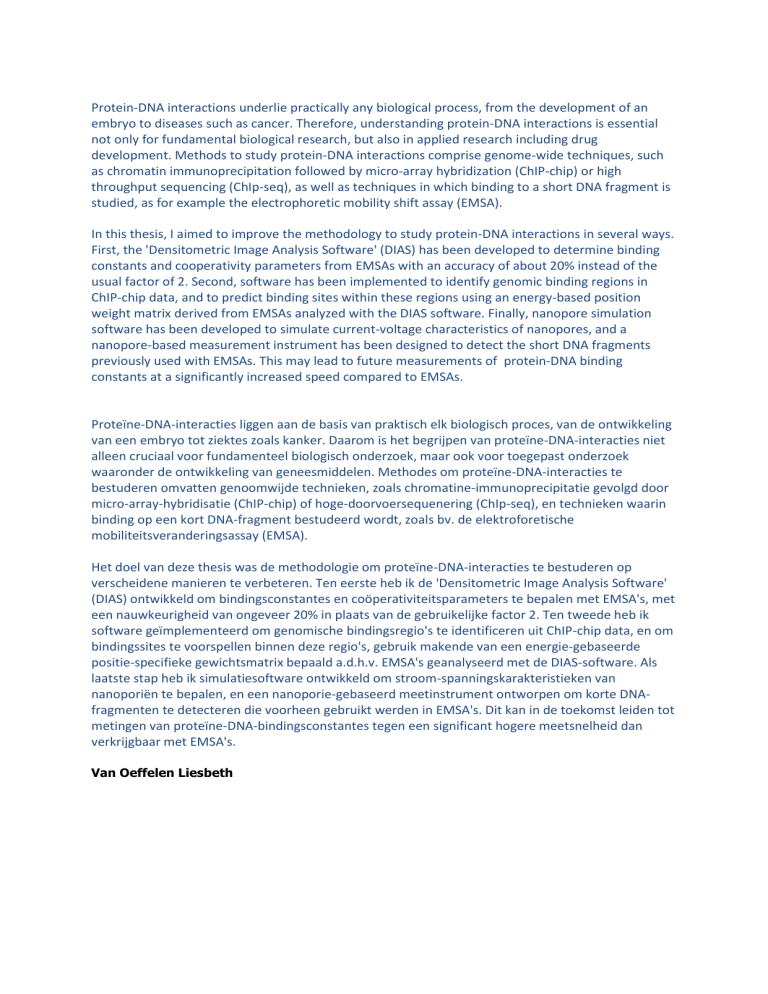
Protein-DNA interactions underlie practically any biological process, from the development of an
embryo to diseases such as cancer. Therefore, understanding protein-DNA interactions is essential
not only for fundamental biological research, but also in applied research including drug
development. Methods to study protein-DNA interactions comprise genome-wide techniques, such
as chromatin immunoprecipitation followed by micro-array hybridization (ChIP-chip) or high
throughput sequencing (ChIp-seq), as well as techniques in which binding to a short DNA fragment is
studied, as for example the electrophoretic mobility shift assay (EMSA).
In this thesis, I aimed to improve the methodology to study protein-DNA interactions in several ways.
First, the 'Densitometric Image Analysis Software' (DIAS) has been developed to determine binding
constants and cooperativity parameters from EMSAs with an accuracy of about 20% instead of the
usual factor of 2. Second, software has been implemented to identify genomic binding regions in
ChIP-chip data, and to predict binding sites within these regions using an energy-based position
weight matrix derived from EMSAs analyzed with the DIAS software. Finally, nanopore simulation
software has been developed to simulate current-voltage characteristics of nanopores, and a
nanopore-based measurement instrument has been designed to detect the short DNA fragments
previously used with EMSAs. This may lead to future measurements of protein-DNA binding
constants at a significantly increased speed compared to EMSAs.
Proteïne-DNA-interacties liggen aan de basis van praktisch elk biologisch proces, van de ontwikkeling
van een embryo tot ziektes zoals kanker. Daarom is het begrijpen van proteïne-DNA-interacties niet
alleen cruciaal voor fundamenteel biologisch onderzoek, maar ook voor toegepast onderzoek
waaronder de ontwikkeling van geneesmiddelen. Methodes om proteïne-DNA-interacties te
bestuderen omvatten genoomwijde technieken, zoals chromatine-immunoprecipitatie gevolgd door
micro-array-hybridisatie (ChIP-chip) of hoge-doorvoersequenering (ChIp-seq), en technieken waarin
binding op een kort DNA-fragment bestudeerd wordt, zoals bv. de elektroforetische
mobiliteitsveranderingsassay (EMSA).
Het doel van deze thesis was de methodologie om proteïne-DNA-interacties te bestuderen op
verscheidene manieren te verbeteren. Ten eerste heb ik de 'Densitometric Image Analysis Software'
(DIAS) ontwikkeld om bindingsconstantes en coöperativiteitsparameters te bepalen met EMSA's, met
een nauwkeurigheid van ongeveer 20% in plaats van de gebruikelijke factor 2. Ten tweede heb ik
software geïmplementeerd om genomische bindingsregio's te identificeren uit ChIP-chip data, en om
bindingssites te voorspellen binnen deze regio's, gebruik makende van een energie-gebaseerde
positie-specifieke gewichtsmatrix bepaald a.d.h.v. EMSA's geanalyseerd met de DIAS-software. Als
laatste stap heb ik simulatiesoftware ontwikkeld om stroom-spanningskarakteristieken van
nanoporiën te bepalen, en een nanoporie-gebaseerd meetinstrument ontworpen om korte DNAfragmenten te detecteren die voorheen gebruikt werden in EMSA's. Dit kan in de toekomst leiden tot
metingen van proteïne-DNA-bindingsconstantes tegen een significant hogere meetsnelheid dan
verkrijgbaar met EMSA's.
Van Oeffelen Liesbeth












